Manufacturing Performance Standards Related to ASTM

New to manufacturing performance standards? Check out this blog post.
Anyone who’s ever covered a wall with sticky notes to clearly map all of the steps in a process knows how valuable that exercise can be. It can streamline workflows, increase efficiency, and improve the overall quality of the end result. That’s also true for resource-efficient manufacturing, thanks to an innovative international standard created by a public-private team led by the National Institute of Standards and Technology (NIST). The standard helps manufacturers “map” the critically important aspects of their processes, leading to significant improvements in performance while keeping a product’s life cycle low-cost and efficient.
However, making these assessments can be difficult, costly, and time consuming, as many manufactured items are created in multiple and/or complex processes, and the impacts of these processes can vary widely depending on how and where the manufacturing occurs. Additionally, the data collected are often unreliable, often not derived through scientific methods, and do not compare well with those from other types of manufacturing processes or from processes at different locations.
These issues are being addressed through a ASTM International standard for characterizing the impacts of manufacturing processes (ASTM E3012-16). The guide provides manufacturers with a science-based, systematic approach to capture and describe information about the impacts for any production process or group of processes, and then use that data to make informed decisions on improvements. The standard is easily individualized for a company’s specific needs.

“It’s similar to using personal finance software at home where you have to gather income and expenditure data, ‘run the numbers’ and then use the results to make smart process changes—savings, cutbacks, streamlining, etc.—that will optimize your monthly budget,” said NIST systems engineer Kevin Lyons, who chaired the ASTM committee that developed the manufacturing standard. “We designed ASTM E3012-16 to let manufacturers virtually characterize their production processes as computer models, and then, using a standardized method, ‘plug and play’ the data for each process step to visualize impacts and identify areas for improving overall sustainability of the system.”
Additionally, key performance indicators (KPIs)—metrics of success (ASTM E3096-17)—for manufacturing performance can be fed back into the E3012-16 standard to make it even more effective. “In the long term, we’ll establish a repository of process models and case studies from different manufacturing sectors so that users of the standard can compare and contrast against their production methods,” Lyons said.
Both E3012-16 and E3096-17 standard guides may be found on the ASTM website.
Contacts
-
(301) 975-8286

